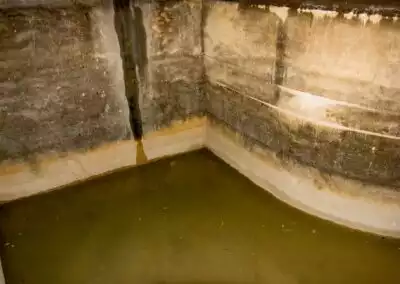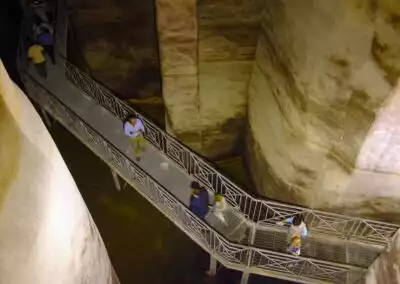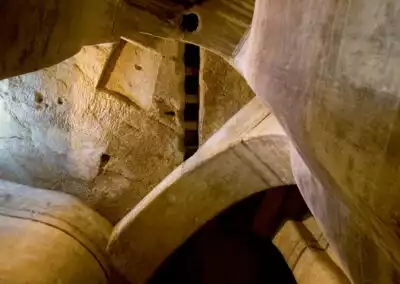Water is a primary element, essential for life and for the survival of humankind. Ever since the most remote times people have taken advantage of prehistoric natural caves which had water, waterways and lakes and provided the necessary supply of water for survival. The clay-rich hilly landscape surrounding the Sassi are studded with numerous spring-fed wells providing drinking water. These wells are faced in ashlar and have openings to allow the water to flow in and out.
The first of these wells were dug in Neolithic times. Those closest to the rupestrian settlement are on the Piano, in convents and stately residences, whilst others can be found in Via Lucana, Via Cappelluti and Via Lanera. A small freshwater lake was said to lie at the foot of the clay-rich hill of Castello, around the area where Piazza San Francesco now stands, and where holes for stakes used in Neolithic era-huts and round ditches for food storage can be traced. This lake would most likely have been drained during building works for the Church of Purgatorio. Due to the clay-rich nature of the soil and the phenomenon of run-off, the water that flowed down the hills of Lanera, Lapillo, Lama Camarda and Caropreso created two deep karst funnels below them, with deep gullies and terraces caused by erosion, where in ancient times the districts of Sasso Barisano and Sasso Caveoso were established. These waters, since at least 1351, were being channelled into an underground aqueduct which fed the public fountain, which was set with a cross. Because the water flow decreased in the summer due to drought, in 1565, it was decided that a round underground chamber be dug, called the Palombaro, to store excess water in winter. In 1577, by order of Monsignor Saraceno, the fountain was replaced with a newer, finer one, topped with a cross as the previous one. Two more palombaro cisterns were later built in the area. The aqueduct and the fountain required periodical maintenance. The term “Palombaro” in Italian comes from the Latin “plumbarius”, which means a person who works lead. In fact, it was the palombaro’s job to coat the pipes of the aqueduct with lead, repair them when they were broken, plaster the cisterns and carry out general maintenance. The palombaro cisterns, plastered with coccio pesto, a mixture of local red clay, similar to Armenian bole, mixed with lime mortar and shards of roof tiles, could be both sizable and very deep and they could store both spring water and rain water. Coccio pesto was also used to clad the city’s fovee, the rock-hewn silos dug in the area known as Dei Foggiali, in Via San Biagio, and wheat could be stored there for up to fifteen years. According to the Materan chronicler Gianfranco de Blasiis, in 1635, the word palombaro may have originated from the Palombaro of Pozzuoli, one of the most important baths of that time. In 1825, as the aqueduct was in a terrible state of repair, two new ones were built, and they would go on to feed the new fountain which was installed in 1832. In 1893, one palombaro was expanded to collect excess water and since then has been called Palombaro lungo (the long palombaro). Monsignor Di Macco in Piazza Duomo dug another palombaro cistern in 1844, and this is known as the Palombaro della Terra, near the church of Carmine and in the open space of the Purgatorio Vecchio Church in the Sasso Caveoso. It collected the water rising from the Lanera hill springs by means of an aqueduct several kilometres long. Whilst for drinking water people relied on the spring-fed wells, aqueducts and public fountains, for other needs water was drawn from the palombari and the cisterns either dug into every cave of the Sassi or built in the yards outside the dwellings. Here, non-drinkable water was drawn for domestic use both for the dwelling itself and for the entire neighbourhood. This water had to be boiled for ten minutes before drinking. Rain water was channelled into the cisterns from the roofs of the dwellings by means of terracotta gutters and drainpipes attached to the façades of the houses, cellars, olive oil mills, cheese production workshops and stables. During summer, when this water supply ran out as well, inhabitants were forced to go down into the Gravina canyon to fill up barrels of water from the Iurio, a whirlpool providing a year-round supply of water, as they had done since the origins of humankind. With the opening of the Pugliese Aqueduct in 1926 a number of cast-iron fountains were built in the Sassi and on the Piano, spread out at regular intervals. Every day women would queue up with their water jugs in order to carry home clean water for drinking and cooking. The countryside around Matera is also dotted with fountains, wells, cisterns, aqueducts and palombari. Some of the larger cisterns of the Murgia are the aforementioned palombari, other cisterns however are condensation types and have a pitched roof shaped covering, while others are like those in the Sassi, dug into the bare rock and bell-shaped or at the foot of a cliff face so that water would run into them during rainstorms. The country fountains are found near large farms, at the intersections of aquifers, and are sometimes fed by aqueducts.




